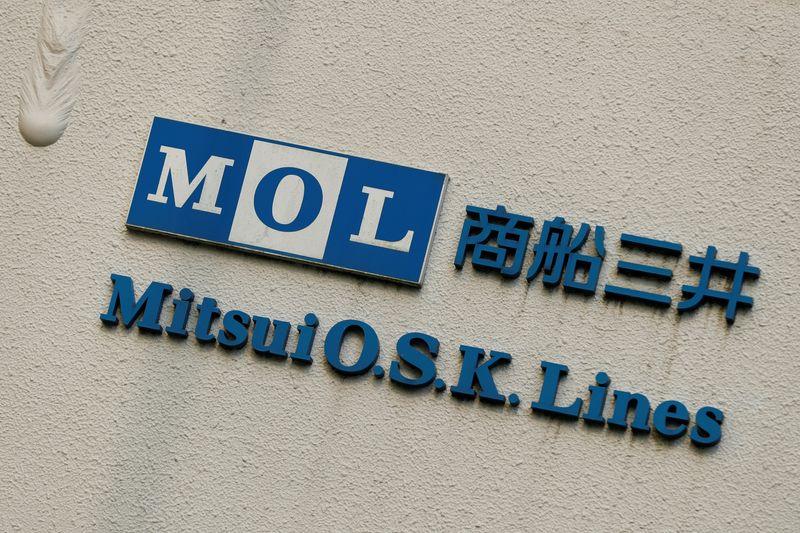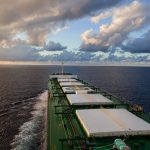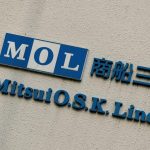The following is a summary of business conditions including revenue and ordinary profit/loss per business segment.
(A)Dry Bulk Business
The Capesize bulker market rates remained firm in October and November, due to steady iron ore shipments from Western Australia and Brazil as well as strong bauxite shipments from West Africa. However, in December, iron ore shipments from Brazil declined, leading to a slack vessel supply and demand balance, which sent market rates plummeting through to the end of the year.
The market rates for Panamax and smaller vessels trended downward, amid weakening of the vessel supply and demand balance caused by decreased Brazilian exports associated with growing domestic demand for corn due to rising gasoline prices and poor harvests of sugarcane used to produce biofuels, as well as limited shipments of coal and other dry bulk cargoes in the Pacific towards the end of the year.
The dry bulk business posted a year-on-year decline in profit due to special factors, specifically, the absence of profit from the reversal for doubtful accounts recorded in last year, which offset improved profitability due to the strong Capesize bulker market rates seen since the first half.
(B)Energy Business
Tankers
The very large crude carrier (VLCC) market rates were mostly unchanged year-on-year, with factors that have pushed up market rates since the previous year, such as limited new vessel supply and the increase in ton- miles associated with rising Atlantic production, offset by the impact of weak demand in China due to its economic slowdown.
The product tanker market rates weakened, reflecting decreased production of petroleum products in response to falling domestic demand in China and weakening of the vessel supply and demand balance after VLCC market rates temporarily fell below product tanker market rates and VLCCs started being used to transport petroleum products.
The LPG carrier market rates softened slightly year-on-year, reflecting no growth in exports from the Middle East due to ongoing OPEC Plus oil output cuts, slow growth in Chinese imports due to its economic slowdown, and a decrease in ton-miles from the summer with the easing of Panama Canal congestion, even though LPG exports from the U.S. remained firm.
The chemical tanker market rates remained favorable, reflecting an increase in ton-miles, as many shipping companies opted to reroute through the Cape of Good Hope in face of tensions in the Red Sea. In addition, Fairfield Chemical Carriers Pte. Ltd. (Fairfield), which became a consolidated subsidiary through the acquisition of its shares in March 2024 by MOL Chemical Tankers Pte. Ltd., a wholly-owned subsidiary of the Company, also contributed to profit growth.
In this business environment, by stably performing existing long-term contracts and by reducing costs, the tanker business as a whole posted a year-on-year increase in profits.
Offshore>
The FPSO business reported a year-on-year increase in profit partly due to the reporting of equity in earnings of affiliates as a result of the revaluation of shares following the conversion of MODEC, Inc. into an equity- method affiliate.
The LNG carrier business continued to generate stable profit through existing long-term charter contracts and the delivery of new vessels, but reported a year-on-year decrease in profit.
The LNG infrastructure business reported increased profit year-on-year as a result of the start of new projects and the stable operation of existing projects.
(C)Product Transport Business
At OCEAN NETWORK EXPRESS PTE. LTD. (ONE), the Company’s equity-method affiliate, the vessel supply and demand balance remained tight, reflecting vessel supply constraints because of continued transit via the Cape of Good Hope combined with increased demand driven by strong shipments mainly on routes from Asia to North America. As a result, spot freight rates exceeded expectations, resulting in substantial year-on- year profit growth.
While shipping demand for completed cars held firm, shipping volume fell year-on-year due to continued avoidance of the Red Sea and delays caused by strikes at certain ports; however, the Car Carrier business posted higher profit due mainly to favorable exchange rates and improved operating efficiency.
In the terminal business, handling volume in the domestic container terminal business remained steady.
However, the logistics business reported year-on-year decline in profit due to weak air and sea freight rates and higher procurement costs despite an increase in air and sea freight handling volumes.
(D)Wellbeing & Lifestyle Business
The real property business achieved a year-on-year increase in profit due to a strong performance at DAIBIRU CORPORATION, the core company in the Group’s real property business, and the posting of equity in earnings of affiliates associated with an increase in equity-method affiliates.
MOL Sunflower Ltd. saw a significant year-on-year increase in liftings driven by modal shift in the cargo transportation business. The passenger transportation business also performed well, with a year-on-year increase in profit.
The cruise business reported a year-on-year decrease in profit, reflecting upfront expenditures such as investment for the entry into service of MITSUI OCEAN FUJI, despite an increase in passengers driven by strong traveling demand.
(E)Associated Businesses
The associated business, including the tugboat business and the trading business, reported year-on-year decline in profit.
(F)Others
Other businesses, which include ship operations, ship management, and financing, reported year-on-year decline in profit.
(A)Dry Bulk Business
The Capesize bulker market rates are expected to remain weak in the January-March quarter due to the usual slowdown in shipments caused by seasonal factors such as the rainy season in Brazil and cyclones in Australia.
The market rates for Panamax and smaller vessels are expected to soften further as shipments decline with the end of the buildup of coal inventories to meet demand for heating and the impact of Chinese New Year; however, with increased economy activity after Chinese New Year and the start of the peak season for South American grain shipments, the vessel supply and demand balance will tighten and market rates are likely to stop declining toward the end of the fiscal year.
In this business environment, profits of the dry bulk business as a whole are expected to decline compared to the previous forecast.
(B)Energy Business
The very large crude carrier (VLCC) market rate is expected to remain firm, given tighter U.S. sanctions targeting Russian and Iranian oil and the new U.S. administration’s support for oil exploration that will lead to increased oil supplies from non-OPEC Plus countries such as the U.S. and Brazil, as well as limited new vessel supply, despite various causes for concern such as the extension of OPEC Plus oil output cuts until the end of 2026 and a decrease in China’s imports due to the faltering economy.
The product tanker market rates are expected to hold firm, as the vessel supply and demand balance will likely remain tight due to a decrease in the number of VLCCs transporting petroleum products and improvement in the refining margin, despite China’s economic slowdown and destabilizing geopolitical risks such as the Middle East situation, which continue to be causes for concern.
The LPG carrier market rates are expected to remain steady due to firm consumer demand in emerging economies such as India and increased shipments from the U.S., despite concerns over weak LPG demand in China due to its delayed economic recovery.
The chemical tanker business is likely to continue performing strongly due to favorable market rates and Fairfield’s year-round contribution to improved earnings.
The offshore business is projected to continue generating stable profits due to existing long-term charter
contracts.
In the liquefied gas business, the LNG carrier business will maintain stable profit as a result of the continuation of long-term charter contracts and the delivery of new vessels slated to enter service under new contracts.
The LNG infrastructure business is expected to make a stable profit through the stable operation of existing projects.
Under such conditions, the energy business as a whole is expected to post higher profit compared to the previous forecast.
(C)Product Transport Business
In the containerships business, we expect higher profit, due to the tighter vessel supply-demand balance resulting from transit via the Cape of Good Hope, despite continued large-scale delivery of new vessels. Spot freight rates are likely to decline due to the decreased demand after Chinese New Year but recover afterwards.
In the car carrier business, shipping demand for completed cars is expected to remain firm, despite constraints on efficient vessel allocation under the impact of strikes at certain ports. We will meet customers’ shipping demand whilst carefully monitoring port congestion, ongoing geopolitical tensions, and the trading policies of governments around the world.
We expect avoidance of Red Sea transits to continue until at least the end of March 2025.
In the terminal business, we anticipate steady handling volumes in the domestic container terminal business and plan to transfer our remaining shares in terminal companies in the overseas container terminal business.
In the logistics business, we will work to recover earnings while seeking to expand handling volumes mainly by continuing to strengthen our sales strategies and overseas networks.
In this business environment, the product transportation business as a whole is expected to post higher profit compared to the previous forecast.
(D)Wellbeing & Lifestyle Business
In the real property business, despite a profit impact from the reconstruction of some properties owned by DAIBIRU CORPORATION, the business is expected to continue generating solid profit due to the high occupancy rates of other properties.
In the business of ferries and coastal RoRo ships, the newly built LNG-fueled ferry Sunflower Kamuy entered service in January 2025 and we will continue steadily tapping into cargo transportation demand. In the cruise business, despite upfront investment and other costs incurred for the entry into service of MITSUI OCEAN FUJI, it entered into service in December 2024, and no major change from our previous forecast is anticipated.
In this business environment, the wellbeing & lifestyle business as a whole is expected to increase its profit compared to the previous forecast.
(E)Associated Businesses
In the tugboat business, we anticipate a decrease in service frequency. However, the trading business is expected to perform strongly. The associated business as a whole is expected to maintain around the same level of profit compared to the previous forecast.
5.Financial Position
Total assets as of December 31, 2024 increased by ¥ 502.8 billion compared to the balance as of the end of the previous fiscal year, to ¥ 4,623.3 billion. This was primarily due to the increase in Vessels.
Total liabilities as of December 31, 2024 increased by ¥ 268.2 billion compared to the balance as of the end of the previous fiscal year, to ¥ 2,019.1 billion. This was primarily due to the increase in Long-term bank loans.
Total net assets as of December 31, 2024 increased by ¥ 234.5 billion compared to the balance as of the end of the previous fiscal year, to ¥ 2,604.2 billion. This was primarily due to the increase in Retained earnings.
As a result, shareholders’ equity ratio decreased by 1.2 percentage points compared to the ratio as of the end of the previous fiscal year, to 56.0%.





